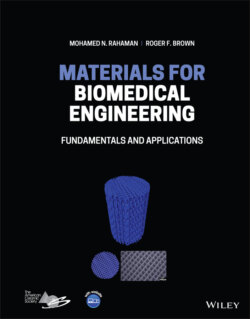Читать книгу Materials for Biomedical Engineering - Mohamed N. Rahaman - Страница 170
5.3.1 Characterization of Surface Chemistry
ОглавлениеIn view of the significant role that surface chemistry plays in determining the performance of materials in biomedical applications and engineering applications as well, several techniques are available to study and characterize the surface chemistry of materials. The most common techniques are Auger electron spectroscopy (AES), X‐ray photoelectron spectroscopy (XPS) also referred to as electron spectroscopy for chemical analysis (ESCA), and secondary ion mass spectroscopy (SIMS) (Table 5.1). AES, XPS, and SIMS are truly surface sensitive techniques in that they provide chemical information about the outermost layer (1–2 nm). They can also provide information from much deeper layers, commonly by sequential or simultaneous removal of surface layers by sputtering the surface with an ion beam and analyzing the sputtered surface, a mode of analysis referred to as depth profiling. A problem with these and most other surface analysis techniques is that they require an ultrahigh vacuum, necessitating the use of dry specimens that often differ in surface chemistry from that of biomaterials implanted in vivo. As noted earlier, in practice, biomaterials are often exposed to the ambient environment for a limited or prolonged period and, consequently, their surface is typically covered with physically and chemically adsorbed water and contaminants such as hydrocarbons.
Table 5.1 Common methods for the surface chemical analysis of materials.
| Measurement parameter | Auger electron spectroscopy (AES) | X‐ray photoelectron spectroscopy (XPS) | Secondary ion mass spectrometry (SIMS) |
|---|---|---|---|
| Incident particle | Electrons (1–20 keV) | X‐rays (1.254 keV; 1.487 keV) | Ions (He+, Ne+, Ar+) (100 eV–30 keV) |
| Emitted particle | Auger electrons (20–2000 eV) | Photoelectrons (20–2000 eV) | Sputtered ions (~10 eV) |
| Element range | >Li (Z = 3) | >Li (Z = 3) | >H (Z = 1) |
| Detection limit | 10−3 | 10−3 | 10−6–10−9 |
| Depth of analysis | 2 nm | 2 nm | 1 nm |
| Lateral resolution | >20 nm | >150 μm | 50 nm–10 mm |
